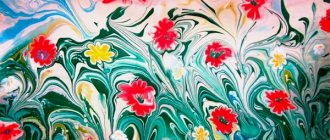Preview:
State budgetary educational institution of the Samara region
Basic secondary school No. 21
The cities of Novokuybyshevsk, Novokuybyshevsk urban district, Samara region
Structural unit “Kindergarten “Gvozdichka”
"Introduction to the profession of an artist"
Prepared by teacher of the highest qualification category Kuchina V.K.
Topic: “Introduction to the profession of an artist”
Educational areas: “Cognitive development”, “Artistic and aesthetic development”, “Speech development”
- introduce children to the profession and creativity of an artist, genres of fine art; enhance cognitive activity;
- to form in children a positive emotional attitude towards visual activity;
- develop fine and gross motor skills;
- encourage the use of a variety of means of expression;
- to instill in children respect for the work of an artist;
- develop children's coherent speech
Description
The profession of an artist is a creative work that requires good imagination, inspiration and mastery of drawing techniques. There are a lot of areas of artistic activity, so the profession has a number of narrower specializations:
- Illustrator. A specialist who creates pictures that describe text.
- Graphic artist. A master working in one contrasting color. Most often it is black. Pencil, ink, etc. are used for drawings.
- Cartoonist. This is a specialist who creates funny portraits or parodies of current events.
- Painter. The name of this industry is the most ancient and it is characterized by drawing from life.
- Fashion designer. This specialist specializes in creating sketches of new clothing collections. An artist who designs an outfit, a trendsetter.
- Copy artist. A specialist who creates copies of paintings and reproductions.
- Restoration artist. These specialists know exactly how to restore masterpieces to their original appearance.
- Specialist in the field of miniature painting.
- Portrait artist. This is working with people in order to fully convey their external characteristics. The transfer can be partial, it all depends on the style in which the master works.
There are many other equally popular areas of activity. The specifics of work in each of them have a number of differences. But one thing remains common - the art of conveying thoughts and fantasies through drawing.
What specialties to study?
In order to become an artist, it is not necessary to receive an education. The main thing is talent, but the absence of a diploma will not allow you to get a good job. Therefore, you should enroll in the following specialties:
- graphic arts;
- design;
- painting;
- artist of monumental and decorative art (painting);
- arts and crafts and folk crafts;
- theatrical and decorative arts;
- fine arts and drawing.
There are other highly specialized specialties.
Drawing a portrait of an artist
Of course, the basis for the success of an artist of any specialization is talent. Without it, it is impossible to create something that will evoke admiration not only from the author himself, but also from customers or ordinary observers. But talent is not a guarantee of success, it is the foundation for an artist, and only in combination with other personal qualities and skills is a professional future possible.
These include:
- Fantasy and rich imagination: an artist must be able to create something unique, original, and not just copy the works of other creators.
- Artistic taste, a sense of harmony: any creation is a combination of harmoniously selected colors and details, otherwise it would be difficult to call it a creation.
- Hard work: an artist's work is the result of his imagination and love for his work. To create something truly worthwhile, you need to make more than one attempt, spend a lot of time and be extremely focused.
- Observation: the artist easily notices even the smallest details both in the world around him, being inspired by them, and in his own works, he draws every little detail.
- Determination and perseverance: imagine if great artists threw their brushes aside every time they didn't succeed? We would never have seen their greatest creations, but the desire to finish what they started did its job. Anyone who sees a clear goal is able to achieve success in their work.
- Visual-figurative thinking, spatial imagination: they help to make unusual things out of ordinary things, to put details into a general concept.
- Color perception: the artist must be able to distinguish colors and correctly combine them with each other.
- The ability to accept criticism: creative activity, like any other, implies certain failures, because not everything always works out the first time. Plus, art is a matter of taste, and you shouldn’t hope that everyone will like your work. There will definitely be critics, and that's completely normal.
As a rule, a love of drawing and most of the listed qualities appear from an early age, but it is rare that childhood hobbies develop into a profession, although you can become an artist after graduating from a specialized educational institution.
Summarize
An artist is not only about the paintings hanging on the walls of our grandparents or placed in the walls of museums, it is about the scope of thoughts, creativity, flight of ideas, endless inspiration and implementation. Artists combine different professions: they are the creators of beautiful pictures in theater and cinema, and those who draw favorite characters in computer games, and craftsmen who bring unique things back to life.
Like any other profession, it requires a serious approach, constant training, development of professional skills, patience and diligence. There is also competition in the creative environment, you shouldn’t forget about it, because there are fewer offers on the labor market than there are specialists, so you won’t be able to relax (of course, if we are talking about generating income, and not just about working for pleasure).
If you have a talent for drawing and you see yourself in this profession, feel free to take the first step: read useful literature, sign up for courses and don’t be afraid of anything. Any professional path is full of challenges and obstacles, and only by going through them do we become true masters of our craft.
Love what you do and everything will work out! Good luck!
We also recommend reading:
- Storytelling
- How to find your calling and change your life for the better
- “Steal like an artist” - ten tips for any kind of creativity
- Sketching for beginners
- Roles You Should Try on to Be Creative
- A selection of useful materials about creativity and creativity development
- Exercises that will awaken your creativity
- 10 most famous artists
- Profession “Designer”: from a simple pencil to high computer technologies
- 15 tasks that will boost your intelligence
- Profession programmer: coder or creator?
Keywords:1LLL
What are artists like?
An artist is a person who practices fine art.
This is a vivid example of the fact that a hobby can be a profession and can generate some income, because, you see, it is impossible to draw without loving this business and without being inspired by it. And if earlier the word “artist” meant an icon painter or someone who painted pictures, now the scope of activity of these professional creators of beauty is very wide.
When choosing a direction of work, future artists should be specific and focused, because now there are so many interesting specializations that it can be dizzying. So let's take a closer look.
Illustrator
An illustrator draws pictures for a specific text. Yes, yes, it was his hands that created those very drawings that we so loved to look at on the pages of fairy tale books. He creates masterpieces not only for literary works, but also for advertising, clothing, websites, etc. This specialist must be able to use various graphic techniques, work in different styles and know the technical side of printing. Basically, it works in the following areas:
- Artistic illustration: the artist “draws” literary works, conveying their meaning through pictures. This direction is more closely connected with art than others.
- Technical Illustration: This refers to schematic illustrations, drawings that are used for instructions, scientific papers, etc.
- Stock illustration: an artist writes something with the goal of selling his creations on relevant services.
- Advertising printing: a specialist works on leaflets, booklets, business cards, etc. This direction is closely related to graphic design.
- Web design: this activity involves the creation of illustrations adapted for a specific website or social networks.
- Branding : now companies care about their uniqueness and recognition in the market, for this they develop their own unique style, or rather, this is exactly what the artist does.
- Comic Drawing: A specialist creates comics for a specific story or as a stand-alone image that can be used for a variety of purposes.
- Game design: this is a real paradise for gaming artists, because their task is to develop static design elements for a computer game or application [Pentaschool, 2020].
As you can see, the profession of an illustrator is very diverse; such scope for the implementation of creative ideas in one specialization is not often found.
Cartoonist
Do you like cartoons? We are sure that even the most serious person has at least one cartoon that he watches with pleasure. A large team works on each cartoon, which cannot do without an animator. Based on the finished script, he creates the very picture that attracts the attention of television viewers.
This professional receives a guide from the director, which describes the emotions of the characters, their appearance and other details. At the same time, the animator (artist) can come up with his own facial expression and add his own twists to the overall concept.
An animator can work in several techniques or develop in a specific one. The main techniques include puppet animation, clay animation, classic 2D and 3D animation. The latter, by the way, is the most popular; cartoons from Pixar and Disney are created using this technique. The profession of an animator is in demand not only in the animation and film industry, but also in companies that deal with video games and advertising [P. Minaeva, 2019].
Concept artist
A concept artist develops a virtual design for something (objects, characters, etc.). Most often, this specialist is in demand in the field of game creation, he works on the overall style of game graphics and individual game elements. Simply put, a concept artist makes quick images with 2D and 3D tools. His task is to create a concept, a certain style, a sketch, to inspire the team, but his work does not go into the final product.
Although this is a creative profession, the artist will not be able to have much fun, because his work must be completed to a specific order, taking into account all the wishes of the client and, as a rule, this is a project activity. In Russia, such specialists are also called 2D and 3D artists. Today, working on Marvel films is the highest level of work for a concept artist [E. Morozova, 2020].
Artist-painter
An artist-painter creates paintings using various tools: paints, pencils, etc. As a rule, this profession is chosen by students who love world fiction, art history, and former schoolchildren who ran to art classes and devoted their free time to art galleries.
Those who have natural talent become painters. This profession opens up many other paths for a specialist: to earn more money, painters work as designers, portrait painters, restorers, etc. The responsibilities of a professional include developing the concept of the painting, planning the stages of work, purchasing the necessary materials, creating sketches, working on the painting and delivering the painting to the customer.
If we talk about a “free flight” painter who does not depend on an employer or a specific project, then this is a person who creates paintings as inspiration, and then exhibits his works at exhibitions and art events, thereby attracting the attention of buyers to his works [ Profguide, 2021].
Graphic designer
A graphic designer is a specialist who uses various techniques of fine art to design something. He paints the facades of buildings, creates interiors, decorates premises for events, develops sketches for landscaping, draws visual aids, designs trading floors, store windows and other premises.
The profession of a graphic designer includes a considerable range of professional and theoretical skills. A specialist must know the trends of modern illustration, the basics of graphic design, painting, drawing, composition, etc. He must be able to work with various art materials, graphic and vector programs, be able to apply different styles in practice and have his own signature style.
Good graphic designers are versatile specialists who can easily fulfill any customer’s request, be it decorating a children’s room or a wedding celebration [British Higher School of Design, 2021].
Artist-designer
The profession of “artist-designer” is often compared with the work of a graphic designer, and some claim that this is the same thing, just “artist-designer” sounds more modern. The designer may not know how to arrange the furniture correctly, but the designer’s responsibilities include design in the first place. He develops graphic diagrams and layouts that clearly demonstrate how all the wishes of clients and the designer’s ideas can be brought to life.
The profession of an engineer-artist is similar in responsibilities, only here we are talking about more detailed work, for example, about creating jewelry: the artist himself thinks through and develops every detail of the product, monitors the quality of the material.
Costume designer
The profession of a costume designer involves working on the images of the characters in a film or play. This specialist is part of a group of creative professionals, led by a production designer. The costume designer first gets acquainted with the script and then creates looks for the actors that will correspond to the overall idea of the plot and the personality of the hero.
Costumes can be simple, everyday, especially when it comes to history taking place today, or they can be historical in nature, conveying the spirit of past times, if you need to tell about events of long ago. In a good play or film, costumes are thought out to the smallest detail; they create an overall artistic concept.
A costume designer designs clothing, interacts with the creative team, selects fabrics and accessories, and controls the process of creating the look. At the same time, he works on the image of not only real actors, but also virtual characters, and the graphic artist brings the idea to life [Profguide, 2021].
Artist-teacher
The profession of an artist-teacher is truly noble, because we are talking about teaching the basics of fine art to children. The specialist teaches you to understand the world through bright colors and drawings that you create with your own hands. The art teacher explains the theoretical basis and teaches various drawing techniques. It combines the skills of a teacher and an artist, and its main goal is to instill in students a love for art, develop their taste, and teach them to see the world from different sides.
This profession is an excellent option for those who love drawing as much as communicating with people and sharing knowledge. Did you like art classes at school or maybe this is your favorite school subject now?
We are convinced that for those who decide to connect themselves with art, the world of professions is truly rich. Such a variety of destinations certainly cannot be called scarce; here everyone will find something that will bring not only pleasure, but also material wealth. But we should not forget that the desire to be an artist must be supported by the presence of personal qualities appropriate to this profession.
Pros and cons of the profession
Perhaps there are no more creative professions than that of an artist. This is a real paradise for those who cannot imagine their life without art and self-realization. You can start your career as an artist at an early age, after graduating from art school or courses, and continue your development as a professional while already a student at a higher educational institution - this is a definite plus.
The variety of areas in which an artist can be useful is impressive. He can work at festivals, workshops, exhibitions, advertising companies and even at home. Here everyone will find something to their liking. And, of course, any creator needs space for action, because creative people do not like to be limited, and this profession allows them to realize the most incredible ideas.
An artist by nature is a free-flying person, and any work, especially under someone else’s guidance, requires a high level of self-organization and discipline, which is very difficult for creative people. This fact can be attributed to the disadvantages of the profession. It is also important to understand that any art is a matter of taste; criticism cannot be avoided here, so the work is classified as stressful. This is especially true for those specialists who carry out orders for clients.
It is the artist's responsibility to keep up with what is relevant and attractive in their field today and to improve their skills. It must satisfy consumer needs, even if its tastes do not coincide with modern trends. Despite the presence of vacancies on the labor market, there is high competition among artists, so it is important to constantly declare yourself as a professional, because the best positions are taken on by the best.
You also need to be prepared for the fact that at the initial stages of gaining experience, the salary may be at the level of the minimum wage. If the listed disadvantages do not outweigh all the delights of the profession, then there is no doubt left: you need to act!
Project “Profession – artist”
Larisa Suslova
Project “Profession – artist”
Profession artist
• Acquaintance with the features of the artist profession
• Explore the varieties of the artist profession
• Make an album of riddles about the profession of an artist
In the life of every person, sooner or later the question arises: what to become and where to go to study?
Choosing a profession is a serious matter ! We need to approach it meaningfully and start thinking about it now.
Where to study
You can get an art education in universities, art schools, or at home from experienced masters of fine art. The following institutions are considered the most prestigious for obtaining such a specialty:
- St. Petersburg State University of Technology and Design.
- Moscow State University of Design and Technology.
- Tolyatti State University.
- Arctic State Institute of Arts and Culture.
What do you have to do at work and specializations?
Daily responsibilities are quite extensive and largely depend on the specialist’s specialization. However, there is also a range of processes common to all specialists:
- Search for customers. The artist himself does this. To do this, he participates in exhibitions and presentations. Also, the search for customers is often carried out via the Internet. Many artists work as freelancers.
- Meeting customers and finding out their needs. Often clients order paintings as gifts, illustrations, portraits, caricatures. The artist must understand as clearly as possible what the clients want. In addition, it is important to demonstrate your work so that customers understand the style in which the author writes. After all, most of the names are not clear to ordinary people. It is precisely because of such mistakes that conflict situations arise.
- Thinking over the concept of a future work. The artist thinks through what he would like to depict and in what context.
- Purchase of necessary materials.
- Creating a sketch. This is a general outline of the future picture, with a visualization of the future location of key objects. It can be compared to a utility diagram.
- The actual drawing process itself. This is the longest stage. It is usually tied to deadlines. The creative process can take place over several months and even years.
- Framing the picture and preparing for delivery.
- Delivery of completed work and settlement with the buyer.
This is far from a complete range of artist responsibilities. It can only expand and increase depending on the specialization of the master.
Who is this profession suitable for?
This profession is suitable for creative people with a well-developed imagination. A true artist knows how to draw inspiration from everything that surrounds him and interpret his emotions into works of fine art.
In addition, self-organization is an important quality for any artist. After all, the working day is mainly structured depending on orders and inspiration. A master must be able to force himself to work even through “I don’t want to.”
Communication skills are very important. After all, an order depends 50% on whether the creator of works of art can please future customers.





